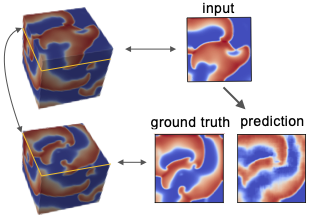Machine Learning
Machine learning tasks in cardiac research include:
data classification (e.g., time series, images, evolution of patterns and shapes) [4], [9]
data driven prediction of future evolution (e.g., membrane voltages, mechanical motion) [2], [3], [5], [6]
cross estimation of observables that are difficult or impossible to measure directly from available data (e.g., electrical excitation waves inside the heart from electrical activity of the surface and/or from mechanical deformation monitored using 4D ultrasound) [1], [2], [5], [6], [7]
extracting relevant features from (noisy) raw data [7], [8], [9]
To address these tasks we use and evaluate various methods from machine learning and statistical learning theory including:
reservoir computing [1], [3], [7]
convolutional neural networks [2], [6], [7], [8]
nearest neigbours prediction of spatio-temporal time series using (dimension-reduced) local states [5]
(nonlinear) dimension reduction [5], [9]
Example 1
Data driven prediction of chaotic spiral wave dynamics using a convolutional auto-encoder [2].
left: true evolution of membrane voltage simulated using the Bueno-Orovio-Cherry-Fenton model
middle: iterated prediction of the neural networks
right: difference between ground truth and prediction
Prediction error becomes significant after about five spiral rotations.
Example 2
Predicting electrical excitation waves in deeper layers of a 3D volume from data at the surface.

References
[1] R.S. Zimmermann and U. Parlitz, Chaos 28, 043118 (2018)
https://aip.scitation.org/doi/10.1063/1.5022276
[2] S. Herzog, F. Wörgötter, U. Parlitz, Frontiers in Appl. Math. and Statistics 4, 60 (2018)
https://www.frontiersin.org/articles/10.3389/fams.2018.00060/full
[3] L.A. Thiede, U. Parlitz, Neural Networks 115, 23 (2019)
https://www.sciencedirect.com/science/article/abs/pii/S0893608019300413?via%3Dihub
[4] P. Amil et al., Sci. Rep. 9, 1157 (2019)
https://www.nature.com/articles/s41598-018-38136-8
[5] J. Isensee et al., J. of Nonlin. Sci. 30, 713–735 (2020)
https://link.springer.com/article/10.1007/s00332-019-09588-7
[6] S. Herzog, F. Wörgötter, Ulrich Parlitz, Chaos 29: 123116 (2019)
https://aip.scitation.org/doi/10.1063/1.5124926
[7] S. Herzog et al., Frontiers in Appl. Math. and Statistics 6, 616584 (2021)
https://www.frontiersin.org/articles/10.3389/fams.2020.616584/full
[8] H. Lilienkamp, T. Lilienkamp, Sci. Rep. 11, 19767 (2021)
https://www.nature.com/articles/s41598-021-99069-3
[9] I. Kottlarz et al., Frontiers in Physiology 11: 614565 (2021)
https://www.frontiersin.org/articles/10.3389/fphys.2020.614565/full